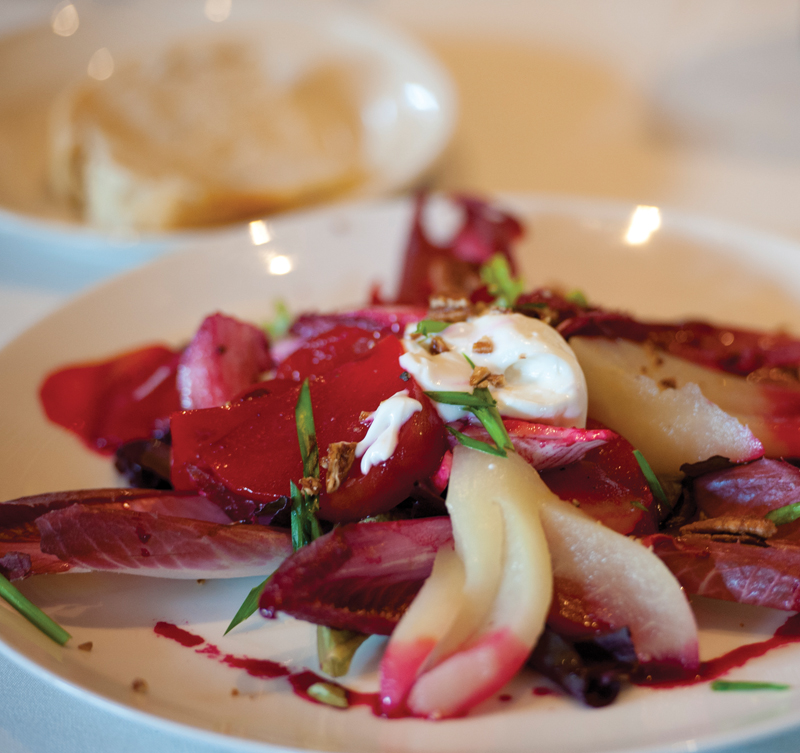Kastner's roasted beet salad fits well with lighter summer menus. But is there enough variety to hold a dinner party featuring only locally sourced foods? Local food experts say there is. Carolyn Pace, Wood River Valley sales representative for the Idaho's Bounty food co-op, said that Wood River Valley residents actually have a more diverse selection of locally produced food than some other areas. Idaho's Bounty, which is based in Hailey, offers everything from fruit and vegetables to local bread, cheese, fish, poultry, nuts and even dog treats. She said it's more than possible to source an entirely local dinner, and at a reasonable price. "There are a lot of organizations which have connections with a lot of vegetable producers, but not a lot of other products," she said. "We have such incredible resources here in Idaho. I eat locally all year long, and I make a nonprofit wage." When to Have It Kastner will take peaches and use them for cobblers and salsa to go with fish, as well as pies and smoothies, using fruit from Waterwheel Gardens in Emmett. The company sells through Idaho's Bounty as well as the Wood River Sustainability Center in Hailey. "They are not the cheapest, but the quality is amazing," Kastner said. "You can tell just by looking how much love is in this fruit. I don't mind paying more money when the product is treated that way." Though Pace admits that summer has its charms when it comes to local produce—namely, blackberries and raspberries—she still has a soft spot for early spring. "When asparagus comes out, that first spring asparagus is so good," she said. Other seasonal produce includes fresh greens, some of which has been wintered over in greenhouses. In late March, Kastner had both wintered-over beets and wintered-over greens on his menu, including a kale blend from Purple Sage Farms in Middleton, about 20 miles north of Nampa. In spring, kale is not as tender as it will be in the summer, but Kastner said the flavor is almost better. "It's hardier, there's more texture, the flavor is more intense, and it's less delicate," he said. "It's not quite as pretty, though." Where to Source It Kastner suggests seeing what produce or meat is of the highest quality, and then determining what to do with it. The farmers markets started on June 10 this year, with hours from 2-6 p.m. on Tuesdays on Fourth Street in Ketchum and from 2-6 p.m. on Thursdays on Main Street in Hailey. Kastner suggests the Wood River Sustainability Center in Hailey for those who can't make it to the farmers markets in town, or before and after they're open. The center, now run by Al and Stephanie McCord, offers a wide variety of products year-round from noon until 6 p.m. Tuesday through Friday and from 10 a.m. to 3 p.m. on Saturdays. The center offers everything from homemade jam and gluten-free bread to bison sausage and sides of beef. Kastner said they even have homemade sour cream, made from fresh local milk. Idaho's Bounty is another option for sourcing. Shopping can be done online at the www.idahosbounty.org website. After members have purchased a $10 annual membership, they are free to browse countless categories and check out online, picking up the food either at NourishMe in Ketchum or the Wood River Sustainability Center between 4-6 p.m. on Wednesdays. What to Serve Kastner said he'd likely start his meal with a cucumber blender soup, consisting of cucumber that has been peeled, seeded and pureed with lemon, dill or mint, and a dairy product such as goat cheese, raw yogurt or kefir to keep the soup from getting too thin. Smoked trout could be used as a garnish. Next, he suggests a simple salad with a ton of greens, probably a mixed kale blend from Purple Sage Farms that includes lacinato, Russian red and curly kale. Kastner suggests "chiffonading the kale"—destemming, rolling the leaves into bundles like cigars, then cutting them perpendicular to the rolls into ribbons. The leaves would then be tossed with a vinaigrette made of lemon, red pepper, salt and pepper and exceptional olive oil—one of the non-local purchases Kastner would recommend. "You can add an apple if they're in season," he said, adding that summer apples might not taste as good as their fall counterparts. For those who would want a more involved salad, he recommends washing and wrapping a few beets in foil, then roasting them in a 350-degree oven until they just begin to "give" a little when pressed—no less than 20 minutes. Then, rub the skin off with paper towels and season with a little lemon juice, salt and pepper, place on a bed of mixed greens, and top with local goat cheese. For the entree, he suggests a lamb sirloin—a cut of meat a little less expensive and a little less tender than a leg of lamb, but with more flavor and texture. Kastner recommends trimming some excess fat, then sprinkling the meat with salt, pepper, rosemary, thyme and garlic, and then grilling over medium-high for no more than 20 minutes. With that, he'd serve steamed potatoes seasoned with salt and pepper and grilled alongside the lamb with minimally seasoned zucchini, eggplant, onions or other vegetables. If cost is a big concern, Kastner said a whole roasted local chicken or grilled trout would suffice. Seem too simple? Kastner said simplicity is the key to cooking local. "You don't have to fuss a lot," he said. "When the stuff is that fresh, you don't want to fuss. You don't want to embellish." "The best food is the simplest food," she said. Why Go Local Kastner began purchasing local food when cooking at the Evergreen restaurant in Ketchum in the mid-1980s. An older gentleman used to arrive at the restaurant with a pickup truck filled with produce of all kinds. Once, on a whim, Kastner bought some of the man's vegetables. He was immediately hooked. "He'd come around at totally random times, but I'd buy just about everything he had," he said. "It was so good." "I had that connection already," he said. "It wasn't a mystery where food comes from. And that's the key to being on top of your skill. It's so much easier when you have good food to work with." Pace said the reason local food tastes so good is that food meant to be consumed locally is produced and raised for taste, while food from larger agricultural corporations is produced to transport well and to have a long shelf life. "For something to travel 2,000 miles and then stay for 20 days on a shelf, it's not going to be very tasty," she said. "It makes a huge difference in flavor. For example, once you have good local eggs just laid by the chickens, you'll never go back." Local food can have a reputation for being more expensive, but Pace said that preconception is not always true. For example, Idaho's Bounty sells local organic ground beef for $5.19 a pound, while the "natural" option at Winco supermarkets sells for about a dollar more. In addition, Pace pointed out that how consumers spend their money makes a huge difference in the local economy. Local farmers also work to keep contaminants out of groundwater and to properly manage water, she said, while avoiding the crop dusting that can happen on larger, corporate farms. "Investing in the local food system means I am investing in the local economy," she said. "So many of those dollars stay in the community, as opposed to money going back to a large corporation. It's an investment in our health as a community." CK's DINNER PARTY MENU Cucumber Blender Soup: Cucumber, raw yogurt, milk or goat cheese, dill and lemon juice garnished with smoked trout. CAROLYN PACE'S PARTY MENU Lamb with Chutney RESOURCES |
|
Copyright 2014 Express Publishing Inc. All Rights reserved. Reproduction in whole or in part in any form or medium without express written permission of Express Publishing Inc. is strictly prohibited. Sun Valley Guide and Habitat magazines are distributed free, four times a year to residents and guests throughout the Sun Valley, Idaho resort area communities. To subscribe to Sun Valley Guide and Habitat magazines visit http://svguide.com/subs |

